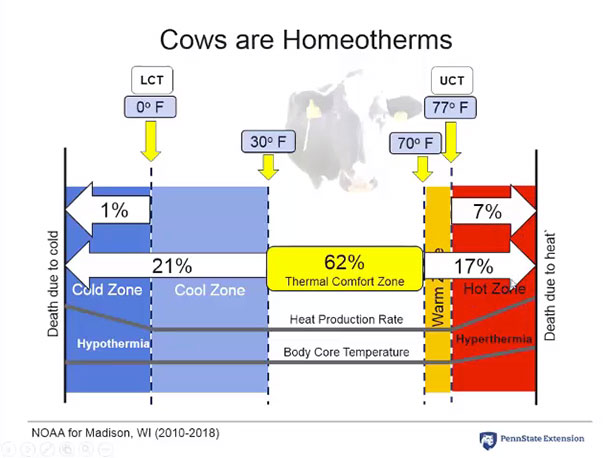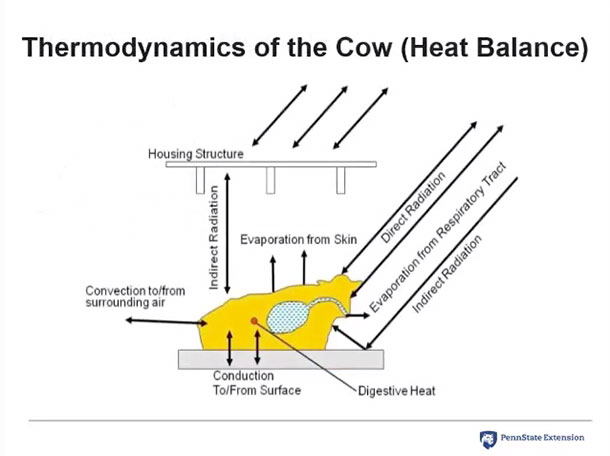Cows ideally like an ambient temperature within the thermal comfort zone of 30ºF and 70ºF, said professional engineer John T. Tyson, an agricultural engineer and educator for Penn State Extension. In a Technology Tuesday webinar titled, “Hot Weather Comfort: Lactating, Dry and Prefresh,” Tyson discussed heat stress concerns and points of focus in cooling cows.
The four basic methods of heat transfer are radiation, conduction, convection and evaporation. By applying those engineering terms to the thermodynamics or heat balance of cows, Tyson said producers should see a need to slow heat gain and/or speed up heat loss in animals. To help combat climate conditions above the thermal comfort zone temperatures, Tyson suggested three keys to heat stress abatement.
1. Decrease solar load with the use of shade and/or nighttime cooling
The number one way farmers can help cows in heat stress, Tyson said, is to provide shade. High, wide and open sheds act as large umbrellas for dairy cattle in summer months. Tarps or simple shade covers over feedbunks can also provide areas of shade. In pastures, shade can be provided naturally by trees or pasture shade structures.
Nighttime cooling on pastures is ideal in terms of radiation. During the day, direct sunlight hits cows and can cause heat stress. However, in the dark, cows cool by radiating heat back into the dark night sky, so nighttime pasture can be a useful tool for some farms or groups of cows.

2. Increase convective cooling with larger air exchange rates and faster air velocity
Convection is dependent upon the temperature and speed of air around cows. Because of this, it is of utmost importance to pay attention to air exchange and air velocity. Tyson recommended several ways to drive air exchange and increase velocity in barns:
Natural ventilation is driven primarily by the area of the inlet in the side of the building and the natural wind speed. Controlling the size of the inlet needs to be of main focus. The ideal amount of sidewall opening is between 7 and 11 square feet per cow. “That would be our goal – to try to achieve a decent summertime air exchange where we can have inside and outside air quality be fairly equal to each other,” Tyson said. It is also important the opening be at the animal level, so cows can see out while fresh air flows in.
Mechanical air exchange via tunnel or cross ventilation is designed around an inlet and fan system. Tunnel ventilation draws air through the barn and is mainly dependent on the width and height of the building; cow numbers have little effect on the design.
Air exchange removes heat from the building, while air speed helps carry heat away from the skin as air flows toward the animal. The goal is to create turbulence and air flow around the cow, ideally at a rate between 3.5 to 5 miles per hour. “That’s really the air speed that we need to penetrate the hair coat,” Tyson said. He cautioned, however, “Circulation fans are not causing any kind of air exchange. They are simply air velocity fans.” Therefore, when circulation fans are used, exchange of the air within the shelter must come from natural or mechanical ventilation.
With the use of circulation fans, it is recommended they be installed over the resting area first, as cows will hopefully spend two times the amount resting than at the feedbunk. If budgets allow, it is encouraged to install them over the feed alley in freestall barns as well, but the main focus should be on the resting area. High-volume, low-speed (HVLS) fans provide another opportunity for air circulation. In either case, don’t forget to clean fans for optimal performance.

3. Increase water and evaporative cooling capability
As water evaporates, it removes heat, and in dairy cattle, that comes from the skin and respiratory tract. The first step of evaporative cooling is to increase water availability and space. Tyson said water consumption can double in hot weather, so it is important to ensure ample drinking water availability.
Evaporative cooling within the barn requires air exchange and velocity before the addition of water to the facility. With that, there are two main ways to approach evaporative cooling: decrease air temperature (indirect cooling) or remove heat directly from the cow (direct cooling).
Indirect evaporative cooling requires the temperature of ambient air be lowered by evaporating water. This is often done by fogging or misting. Small water droplets are injected into the air stream where they evaporate and thus lower the temperature of ambient air. High air speeds and fine water droplets are necessary in this situation to ensure water does not hit the cow, but rather evaporates and cools the air around her. If water lands on the hair coat of a cow, it may rest on the surface and trap in heat rather than cool the animal.
Direct evaporative cooling removes the heat directly from the cow itself through the use of large water droplets. “We are trying to penetrate inside that hair coat,” Tyson said. “So it needs to be a very large, heavy drop that would go through the hair coat and down to the skin.” Tyson said it is estimated that 75% to 80% of the heat used to evaporate that water comes directly from the cow if skin is wetted properly. With a sprinkler design, he encourages the use of nozzles that release 0.5 to 0.75 gallons per minute to ensure the animal is wet within 60 seconds. It is ideal to reapply water every five to 15 minutes, depending on the temperature.
Between the two, direct evaporative cooling systems tend to require more water than indirect systems. With the higher water usage, there is also greater chance that water not landing on an animal will be wasted. On the positive side of direct systems, however, what does reach the cow removes more heat.
When deciding between indirect and direct evaporative cooling, Tyson believes there is no complete advantage of one over the other. “They’re two different systems with two different methods, and you really have to know which one is going to fit into your management style, your shelter requirements and how it is going to work on your farm,” Tyson said.
For a simple way to remember the four main topics of importance when striving for heat abatement, follow the acronym SAAW: shade, air exchange, air velocity and water.
Keep SAAW in mind as you work to beat the summer heat stress battle. ![]()
Courtney Moser is a 2019 Progressive Dairy intern.
PHOTO 1: To exemplify the concerns of heat stress, Tyson shared weather data from a study in Pennsylvania. This shows the percent of time cows spent in each temperature zone. Notice nearly a quarter of time was spent beyond the thermal comfort zone.
PHOTO 2: Weather data from a cow climate study in Wisconsin shows cows there spent 21% of time in the cool-to-cold zone, but they also spent 17% in the warm-to-hot zone.
PHOTO 3: Radiation, conduction, convection and evaporation are shown in correlation to a cow. There is a need to slow heat gain and/or speed up heat loss in animals in order to achieve heat abatement. Photos courtesy of Penn State.






